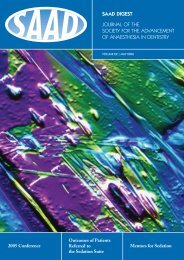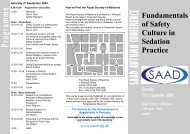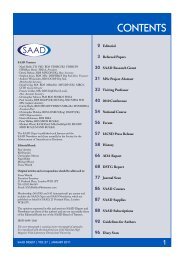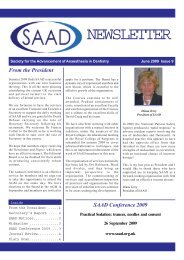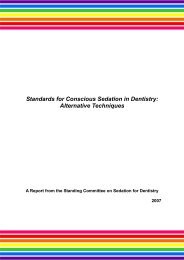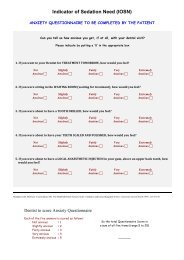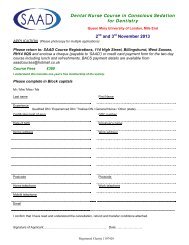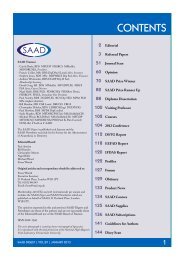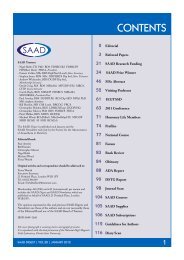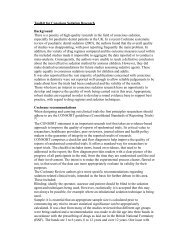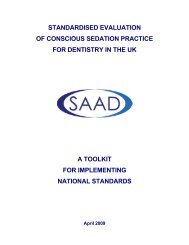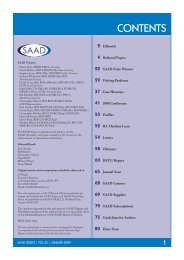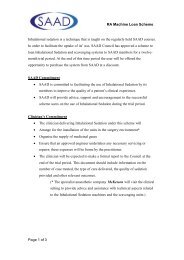Volume 24 - The Society for the Advancement of Anaesthesia in ...
Volume 24 - The Society for the Advancement of Anaesthesia in ...
Volume 24 - The Society for the Advancement of Anaesthesia in ...
Create successful ePaper yourself
Turn your PDF publications into a flip-book with our unique Google optimized e-Paper software.
REFEREED PAPER<br />
Investigat<strong>in</strong>g <strong>the</strong> lived experiences<br />
<strong>of</strong> children and <strong>the</strong>ir parents who<br />
have been referred to a primary care<br />
sedation service<br />
Dr P.A. Averley and Dr R. Hobman (dentists and <strong>in</strong>vestigators), Queensway Dental Practice & Anxiety<br />
Management Cl<strong>in</strong>ic, Bill<strong>in</strong>gham.<br />
Pr<strong>of</strong>. S. Bond, Head, School <strong>of</strong> Population and Health Sciences, University <strong>of</strong> Newcastle upon Tyne.<br />
Dr N.M. Girdler, Consultant, Sedation Department, School <strong>of</strong> Dental Science, University <strong>of</strong> Newcastle upon Tyne.<br />
Pr<strong>of</strong>. J. Steele, Pr<strong>of</strong>essor <strong>of</strong> Health Service Research, School <strong>of</strong> Dental Science, University <strong>of</strong> Newcastle upon Tyne.<br />
Abstract<br />
Anxiety is a major barrier to access<strong>in</strong>g dental care <strong>for</strong><br />
a large group <strong>of</strong> patients. Anxiety can also be a cause<br />
<strong>of</strong> significant distress to patients undergo<strong>in</strong>g dental<br />
treatment.<br />
<strong>The</strong> study presented here is an <strong>in</strong>vestigation <strong>of</strong> <strong>the</strong> lived<br />
experiences <strong>of</strong> children, and parents <strong>of</strong> children, who have<br />
received dental treatment under conscious sedation (as<br />
an alternative to dental general anaes<strong>the</strong>sia <strong>in</strong> hospital) at<br />
Queensway Anxiety Management Cl<strong>in</strong>ic (a primary care<br />
based specialist conscious sedation referral service).<br />
Focus group discussions were held separately with<br />
children and <strong>the</strong> parents <strong>of</strong> those children who had<br />
received care on referral. Discussions were facilitated<br />
us<strong>in</strong>g a topic guide to stimulate dialogue. <strong>The</strong> dialogue<br />
was recorded <strong>for</strong> subsequent transcription and analysis.<br />
<strong>The</strong> results provided an <strong>in</strong>sight <strong>in</strong>to <strong>the</strong> lived experiences<br />
<strong>of</strong> anxious children and <strong>the</strong> lived experiences <strong>of</strong> <strong>the</strong><br />
parents <strong>of</strong> those children. This will direct service<br />
developments and our future research agenda.<br />
Acknowledgements<br />
Our thanks to all <strong>the</strong> children and <strong>the</strong>ir parents who<br />
took part <strong>in</strong> <strong>the</strong> focus groups. Particular thanks to<br />
Joanne, Nad<strong>in</strong>e and Sarah at <strong>the</strong> practice <strong>for</strong> all <strong>the</strong>ir<br />
adm<strong>in</strong>istrative support. Thanks to Pat Baker <strong>for</strong><br />
transcrib<strong>in</strong>g tapes <strong>in</strong>to verbatim transcripts. Thanks also<br />
go to <strong>the</strong> National Coord<strong>in</strong>at<strong>in</strong>g Centre <strong>for</strong> Research<br />
Capacity Development (NCC RCD) <strong>for</strong> <strong>the</strong>ir support<br />
through a Personal Development Award.<br />
Keywords<br />
Conscious sedation, dental anxiety, sev<strong>of</strong>lurane,<br />
<strong>in</strong>travenous midazolam, paediatric anxiety management.<br />
Correspondence<br />
Paul Averley, 170 Queensway, Bill<strong>in</strong>gham, Teesside TS23<br />
2NT. Email: paul@averley.com.<br />
Background<br />
Queensway Anxiety Management Cl<strong>in</strong>ic (QAMC)<br />
is a referral-based primary care dental practice <strong>in</strong><br />
Bill<strong>in</strong>gham, Teesside, UK (1) . Referrals are received from<br />
dental practices throughout <strong>the</strong> county and adjo<strong>in</strong><strong>in</strong>g<br />
counties. Each year, approximately 8,000 children and<br />
adults are treated at <strong>the</strong> practice us<strong>in</strong>g a variety <strong>of</strong> anxiety<br />
management techniques depend<strong>in</strong>g on <strong>the</strong> <strong>in</strong>dividuals’<br />
level <strong>of</strong> anxiety, <strong>the</strong>ir ability to cooperate and/or <strong>the</strong><br />
<strong>in</strong>vasiveness <strong>of</strong> <strong>the</strong> <strong>in</strong>tended procedure.<br />
<strong>The</strong> first l<strong>in</strong>e <strong>of</strong> treatment <strong>for</strong> children referred to<br />
QAMC is a comb<strong>in</strong>ation <strong>of</strong> behavioural management and<br />
relative analgesia (RA). However, RA does not provide<br />
adequate anxiety management <strong>for</strong> all children <strong>in</strong> all<br />
cases. Extremely anxious children, or those undergo<strong>in</strong>g<br />
particularly <strong>in</strong>vasive procedures, may require greater<br />
control <strong>of</strong> <strong>the</strong>ir anxiety than RA alone can provide.<br />
In response to this, conscious sedation (CS) techniques<br />
were developed at QAMC to provide a greater level<br />
<strong>of</strong> support <strong>for</strong> patients (3–7) . <strong>The</strong> aim <strong>of</strong> <strong>the</strong>se CS<br />
SAAD DIGEST | VOL.<strong>24</strong> | JANUARY 2008 3




